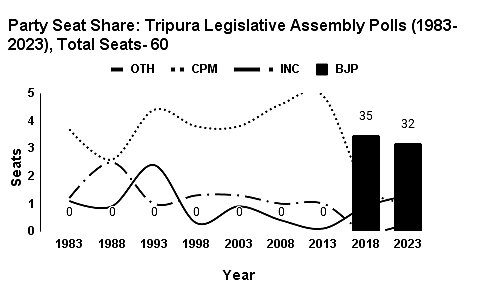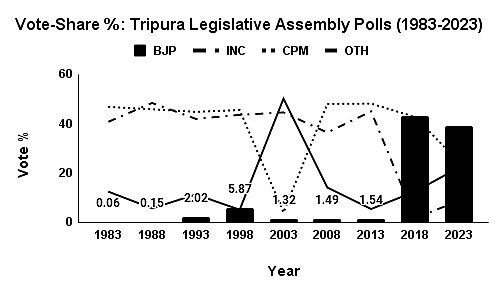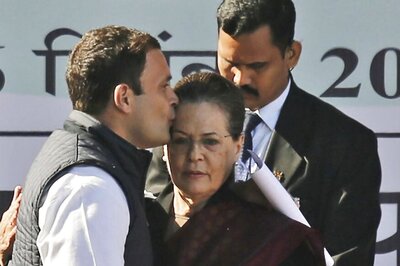
views
A day after campaigning ended for the Nagaland and Meghalaya elections last month, Prime Minister Narendra Modi tellingly presented a Meghalaya stole and a Nagaland shawl to visiting German chancellor Olaf Sholtz. It was typical political symbolism by a leader whose ascent as prime minister in 2014 presaged a tectonic shift in political power equations in India’s northeast states. Outside of the local political dynamics of Agartala, Kohima, and Shillong, the results of the latest assembly elections indicate that the processes that drove this wider reframing of the regional political chessboard over the last eight years by Modi’s new BJP have deepened and taken greater root.
This has significant implications for national politics on the road to 2024. Here are 5 key takeaways from these elections:
1. Historical political shift in Northeast
In Tripura, the BJP had never won an assembly seat till 2018. For example, it won 0 seats in 2013 with 1.5% votes. However, in 2018, the party stormed to power in Agartala, ending over two decades of Left rule. The BJP’s 2018 breakthrough could have been seen then as a one-off.
Five years later, it has retained the state after trouncing a once-unthinkable Left and Congress alliance. The BJP did this, after changing chief ministers mid-stream, like it did earlier in Uttarakhand and Gujarat.
Crucially, Tripura is a state with a sizeable tribal population, where the rise of the Tipra Motha led by former royal family scion Pradyot Manikya Deb Burman indicates new rumblings at the ground level.
Despite this, the fact that the BJP won 39% vote-share in a state where it was basically non-existent until 2018, is a good indicator of the deeper shift in the state’s polity (see Figure 1)
Figure 1: BJP’s Stunning Rise in Tripura Politics


Source: ECI data. Analysis by author, charts adapted from The New BJP.
In Nagaland, where BJP was a junior partner in the previous government, the party has replicated its previous seats tally and increased its own vote share to 18.9% in a clear majority for the NDPP-BJP alliance. In Meghalaya, where BJP was allied with Conrad Sangma’s ruling NPP until just before the elections, it has marginally increased its seat tally.
2. BJP predominant national party in Northeast
Across Nagaland, Tripura, and Manipur, the BJP has won about 50 assembly seats. This is approximately 6 times that of the erstwhile dominant national party, the Congress, whose poll tally, at last count, stood at 8 seats.
These results underscore the continuing electoral retreat of the Congress from states it dominated for decades.
The BJP, using a differentiated political strategy that varied greatly from its imagery in north India and the Hindi heartland, has acquired a “permanent address” in the region. Consider this: until 2016, the BJP had never been elected to power in any of the region’s eight states. However, by 2023, it held office in six of eight northeastern states, four of them on its own steam, with BJP chief ministers leading multi-party coalitions: Tripura (2018 and 2023), Assam (2016 and 2021), Arunachal Pradesh (2016 and 2019), and Manipur (2017 and 2022).
Figure 2: BJP’s Coalitions in Northeast (2016-2023)

Source: Research analysis by Nalin Mehta, The New BJP.
3. Not just a “Hindi-Hindu” party
These results allow the BJP to claim that it is more than a Hindi-Hindu party, and the national inheritor of the Congress’s old mantle as the only pan-Indian party.
Crucially, as much as 87.9% of Nagaland is Christian. So is 74.5% of Meghalaya. Most are from tribal populations. Like about one-third of Tripura. In 2018, after its first big successes in the Northeast, Home Minister Amit Shah emphatically declared that “the taunt about us that the BJP is not an akhil-Bhartiya [all-India] party has been proved wrong”. That claim is now even stronger.
4. Congress down in Northeast
The Congress was once the primary opposition party in Tripura. In 2023, even after a once-unimaginable alliance with the CPI-M in the state, it won only 3 seats and an 8.6% vote share.
In Meghalaya, the Congress was the single largest party in the state in 2018, with 21 seats. But it couldn’t form the government. In 2023, it has been reduced to just 5 seats.
In Nagaland, it scored a blank.
These results are bound to raise further question marks on the larger prospects for Congress’s revival and the longer-term electoral outcome of Rahul Gandhi’s Bharat Jodo Yatra.
5. BJP looks to Northeast gains in 2024
Overall, the BJP emerged as the single largest party in the Northeast in the 2019 Lok Sabha polls – winning 14 of 25 Lok Sabha seats in the region, with a 33.7% vote share. This compared to its 8 seats in the region in 2014.
Now, as we head into the 2024 national elections, the BJP will be looking to further increase its Northeast tally in the big national contest next year.
Nalin Mehta, an author and academic, is the Dean of School of Modern Media at UPES University in Dehradun, a Non-Resident Senior Fellow, Institute of South Asian Studies at the National University Singapore, and Group Consulting Editor, Network18. He is the author of The New BJP: Modi and the Making of the World’s Largest Political Party. The views expressed in this article are those of the author and do not represent the stand of this publication.
Read all the Latest Opinions here

















Comments
0 comment